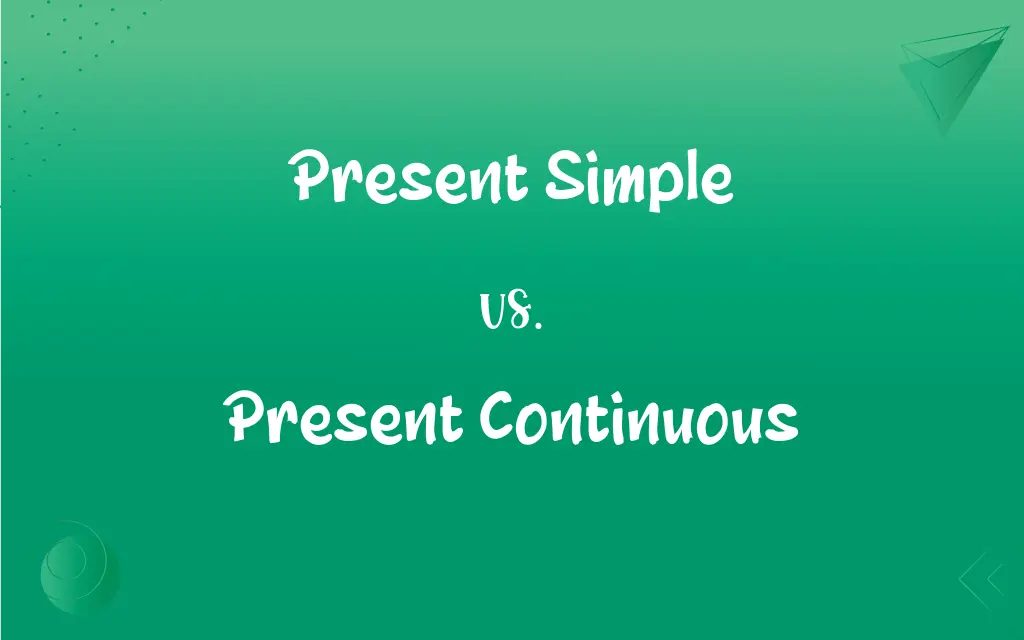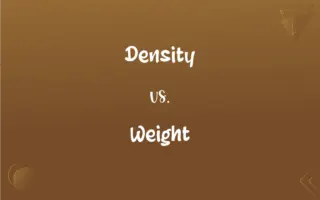Present Simple vs. Present Continuous: What's the Difference?
Edited by Janet White || By Harlon Moss || Published on November 23, 2023
Present simple describes habitual or constant actions, while present continuous is used for actions happening at the moment of speaking or current temporary situations.

Key Differences
The present simple tense is used to express habitual or general truths, such as routines or facts. In contrast, the present continuous tense indicates actions currently happening or temporary situations.
Present simple is structured with the base form of the verb for most subjects, and with an added 's' or 'es' for third-person singular. The present continuous is formed using the verb 'to be' and the '-ing' form of the main verb.
In present simple, adverbs of frequency like 'always', 'often', and 'sometimes' are commonly used to indicate regularity. Present continuous often employs time expressions like 'now', 'at the moment', or 'currently'.
Present simple is not used for actions that are happening at the moment of speaking. Present continuous, on the other hand, is specifically for actions in progress at the time of speaking or for ongoing situations.
While present simple is for facts and regular actions, present continuous can also express future arrangements or plans, especially with verbs of motion.
ADVERTISEMENT
Comparison Chart
Usage
Habitual actions, general truths
Actions happening now, current temporary situations
Form
Base verb (s/es for third person singular)
'To be' + verb-ing
Common Time Expressions
Often, always, sometimes
Now, at the moment, currently
Example of Use
"She speaks English."
"She is speaking English now."
Indication of Action Timing
Not time-bound, general actions
Specific to current or ongoing actions
ADVERTISEMENT
Present Simple and Present Continuous Definitions
Present Simple
Present simple expresses regular or habitual actions.
She goes to the gym every day.
Present Continuous
Present continuous depicts temporary situations.
She is staying with her friend this week.
Present Simple
Present simple depicts routines or fixed arrangements.
He teaches English on Mondays.
Present Continuous
Present continuous is for actions occurring at the moment of speaking.
I am reading a book right now.
Present Simple
Present simple is used for stating facts or general truths.
The sun rises in the east.
Present Continuous
Present continuous can indicate near future plans.
We are leaving for Paris tomorrow.
Present Simple
Present simple describes permanent situations or states.
She lives in New York.
Present Continuous
Present continuous shows actions in progress currently.
He is learning to play the piano.
Present Simple
Present simple is for actions not specifically tied to the present moment.
They prefer coffee over tea.
Present Continuous
Present continuous is used for ongoing actions.
They are working on a new project.
FAQs
What’s the main use of present simple?
For habitual actions and general truths.
What’s the main use of present continuous?
For actions happening at the moment or current temporary situations.
How is present continuous formed?
'To be' + verb with '-ing'.
Can present simple express future actions?
Rarely, usually for scheduled events.
How is present simple formed?
Base verb, with 's' or 'es' for third-person singular.
Is present continuous used for habits?
No, it’s for actions happening now or temporary situations.
What time expressions are common with present simple?
Often, always, sometimes.
What time expressions are used with present continuous?
Now, at the moment, currently.
Can present simple be used for current actions?
No, it’s for habitual actions or general truths.
Does present simple need auxiliary verbs?
No, it uses the main verb only.
Are adverbs of frequency used with present continuous?
Rarely, as it focuses on current actions.
Can present simple and present continuous be interchangeable?
Rarely, as they serve different purposes.
Does present continuous require auxiliary verbs?
Yes, the verb 'to be' as an auxiliary.
What is an example of present continuous in a question?
"Are you playing tennis right now?"
Is present continuous ever used for future plans?
Yes, especially for near future arrangements.
Can present simple describe temporary situations?
No, it describes regular actions or permanent states.
How does context affect the use of present continuous?
It depends on whether the action is current or temporary.
What is an example of present simple in a question?
"Do you play tennis?"
Is present continuous suitable for general truths?
No, it’s for current or ongoing actions.
How does context affect the use of present simple?
It’s influenced by the habitual or general nature of the action.
About Author
Written by
Harlon MossHarlon is a seasoned quality moderator and accomplished content writer for Difference Wiki. An alumnus of the prestigious University of California, he earned his degree in Computer Science. Leveraging his academic background, Harlon brings a meticulous and informed perspective to his work, ensuring content accuracy and excellence.
Edited by
Janet WhiteJanet White has been an esteemed writer and blogger for Difference Wiki. Holding a Master's degree in Science and Medical Journalism from the prestigious Boston University, she has consistently demonstrated her expertise and passion for her field. When she's not immersed in her work, Janet relishes her time exercising, delving into a good book, and cherishing moments with friends and family.






































































